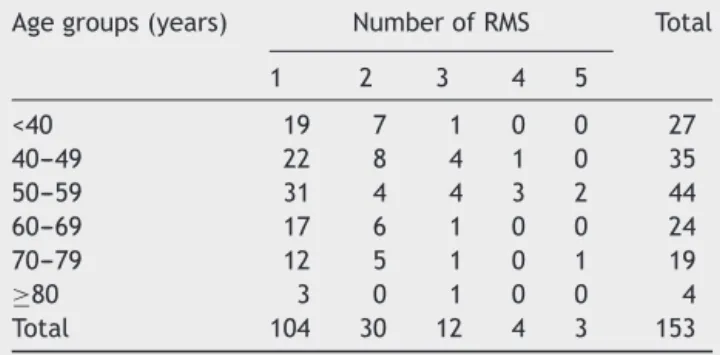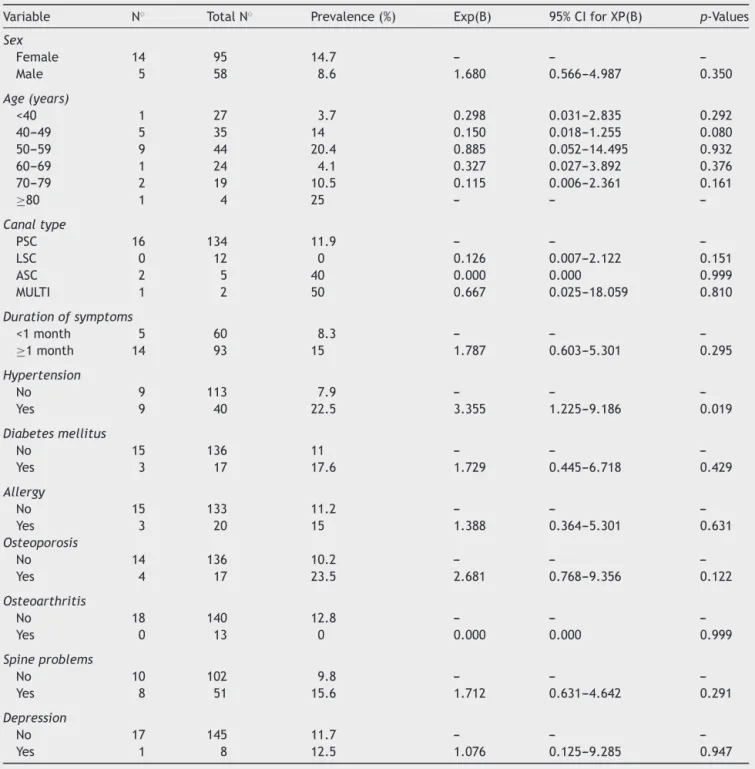www.bjorl.org
Brazilian
Journal
of
OTORHINOLARYNGOLOGY
ORIGINAL
ARTICLE
Cases
requiring
increased
number
of
repositioning
maneuvers
in
benign
paroxysmal
positional
vertigo
夽
Mukadder
Korkmaz
∗,
Hakan
Korkmaz
DepartmentofOtorhinolaryngologyHeadandNeckSurgery,OrduUniversityMedicalSchool,Ordu,Turkey
Received7August2015;accepted26August2015 Availableonline4November2015
KEYWORDS
Benignparoxysmal positionalvertigo; Repositioning maneuver; Hypertension; Comorbidity
Abstract
Introduction:Benignparoxysmalpositionalvertigo(BPPV)isaclinicalsyndromethatis pro-posedtobecausedbydislocatedutriculardebrisintosemicircularcanals.Althoughthemajority ofpatients aretreatedby oneor two repositioningmaneuvers, some ofthepatients need repeatedmaneuversforrelief.
Objective:Thegoalofthisstudywastoinvestigatethefactorsassociatedwithpatientswith benignparoxysmalpositionalvertigowhorequiredmultiplerepositioningproceduresfor treat-ment.
Methods:Datawereobtainedfromtheclinicalrecordsof153patientsdiagnosedwithbenign paroxysmalpositionalvertigo.Patientsweretreatedbyrepositioningmaneuvers.Demographic dataandthefactorsincludingage,sex,canaltype,durationofsymptoms,comorbiditiesand numberofrepositioningmaneuversforreliefweredocumentedforstatisticalanalysis.
Results:Age,sex,canaltypeandthedurationofsymptomshadnoimpactonthenumberof maneuvers.The mostcommon comorbiditywas spineproblems. Hypertensionwas theonly comorbiditythatsignificantlyassociatedwithincreasednumberofmaneuvers.
Conclusion:The presenceofhypertensionisariskfactor forrepeatedmaneuversinbenign paroxysmalpositionalvertigotreatment.Physiciansshouldbeawareoftheincreased probabil-ityofrepeatedrepositioningmaneuversinthesegroupofpatients.Theroleofcomorbidities andvascularfactorsneedtobefurtherclarifiedinthecourseofbenignparoxysmalpositional vertigo.
© 2015 Associac¸˜ao Brasileira de Otorrinolaringologia e Cirurgia C´ervico-Facial. Published by Elsevier Editora Ltda. This is an open access article under the CC BY license (http:// creativecommons.org/licenses/by/4.0/).
夽 Pleasecitethisarticleas:KorkmazM,KorkmazH.Casesrequiringincreasednumberofrepositioningmaneuversinbenignparoxysmal
positionalvertigo.BrazJOtorhinolaryngol.2016;82:452---7.
∗Correspondingauthor.
E-mail:mukadderkorkmaz@gmail.com(M.Korkmaz).
http://dx.doi.org/10.1016/j.bjorl.2015.08.018
PALAVRAS-CHAVE
Vertigemposicional paroxísticabenigna; Manobrade
reposicionamento; Hipertensão; Comorbidade
Casosdevertigemposicionalparoxísticabenignaqueexigemumasériedemanobras dereposicionamento
Resumo
Introduc¸ão: Avertigemposicionalparoxísticabenigna(VPPB)éumasíndromeclínica proposta-mentecausadapordetritosutricularesdesprendidosdentrodoscanaissemicirculares.Embora amaioriadospacientessejatratadacomumaouduasmanobrasdereposicionamento,alguns pacientesprecisamdemanobrasrepetidasparaoalíviodossintomas.
Objetivo: OobjetivodesteestudofoiinvestigarosfatoresassociadosapacientescomVPPB queprecisamdeváriosprocedimentosdereposicionamentoparaotratamento.
Método: Osdadosforamobtidosapartirdeprontuáriosmédicosde153pacientes diagnosti-cadoscomVPPBetratados.Ospacientesforamtratadoscommanobrasdereposicionamento. Osdadosdemográficosefatores,incluindoidade,sexo,tipodecanal,durac¸ãodossintomas, comorbidadesenúmerodemanobrasdereposicionamentoparaalívio,foramregistradospara análiseestatística.
Resultados: Idade,sexo,tipodecanaleadurac¸ãodossintomasnãotiveramimpactosobreo númerodemanobras.Acomorbidademaiscomumfoiproblemasdecoluna.Hipertensãofoia únicacomorbidadesignificantementeassociadaaoaumentodonúmerodemanobras.
Conclusão:Apresenc¸adehipertensãoéumfatorderiscoparanecessidadedemanobras repeti-dasnotratamentodaVPPB.Osmédicosdevemestarcientesdoaumentodaprobabilidadede manobrasdereposicionamentorepetidasnessegrupodepacientes.Opapeldascomorbidades edosfatoresvascularesprecisasermaisbemesclarecidonocursodaVPPB.
© 2015 Associac¸˜ao Brasileira de Otorrinolaringologia e Cirurgia C´ervico-Facial. Publicado por Elsevier Editora Ltda. Este ´e um artigo Open Access sob uma licenc¸a CC BY (http:// creativecommons.org/licenses/by/4.0/).
Introduction
BPPV (benign paroxysmal positional vertigo) is a clinical syndromecharacterizedbybrief,recurrentepisodesof ver-tigo provoked by certain head positions with respect to gravity. It is the most common cause of peripheral ves-tibular vertigo with an estimated lifetime prevalence of 3.2%in females,1.6% inmalesand2.4% overall.1 InBPPV it was proposed that degenerative debris dislodged from utricule into the semicircular canals results in inappro-priate deflection of cupula by either deposition of debris ontocupula,namelycupulolithiasis,orfreefloatingdebris in theendolymph, namely canalithiasis.2 The diagnosis of BPPV is based on clinical findings of transient nystagmus provoked bycertainhead positionscalled Dix-Hallpikefor posterior and anterior canals or supine roll test for lat-eralcanal.3Therearemanytypesofcanalithrepositioning maneuvers with good efficacy in maintaining rapid and sustained resolution of symptoms. Posterior and anterior semicircular canal BPPV is treated mainly by the meth-odsproposedbyEpley4andSemontetal.5Inlateralcanal BPPV, barbecue maneuver consisting of 360◦
rotation of the patient is the most commonly used method.6 The majority of the patients need one or two treatment vis-itsfor relief.However,a considerable numberofpatients require multiple treatment visits for resolution of symp-toms.
The aimofthisstudywastoidentifythevariablesthat mayberelatedtothosecaseswhichneedanincreased num-berofrepositioningmaneuversforrelief.
Methods
Patientswereinstructedtosleepinahead-uprightposition fortwodaysandavoidupanddownmovementsofthehead. Aftertherepositioningtreatment,patientswereseeninthe clinic on a weekly basis and repositioning maneuver was repeateduntilthepatientswererelievedofBPPV.Reliefwas definedastheabsenceofnystagmusandsymptomofvertigo duringDix-HallpikeorRolltests.Forstatisticalanalysis, chi-squaretestandlogisticregressionanalysiswereused.Values ofplowerthan0.05wereconsideredtoindicatestatistical significance.
Results
Atotalof153patientswereincludedinthestudy(95female and58 male; average age: 53.6; agerange 17---87 years). The right ear was affected in 79 patients, left ear in 73 and bilateral disease was seen in one patient. PSC was involvedin134(87.6%)patients,LSCin12(7.8%),andASC infive(3.3%)patients.Multiplecanalinvolvementwasseen in two (1.3%) patients. The most frequent seven comor-biditiesreported by patients were as follows:cervical or lumbarspineproblems(herniatednucleuspulposus, spondy-lolisthesis,flattening of cervical lordosis and undiagnosed cervical or back pain) in 51 (33.3%) patients, hyperten-sionin40(26.1%),allergyin20(13.1%),diabetes mellitus in17 (11.1%),osteoporosis in 17(11.1%),osteoarthritis in 13 (8.5%), and depression in eight (5.2%) patients. The average duration of symptoms was 53 weeks (range one day---20years,median threeweeks).Thenumber of repo-sitioningmaneuvers(RM)requiredfortreatmentwasshown withrespecttogender(Table1),age(Table2),canaltype (Table3)and theduration ofsymptoms beforetreatment (Table4).Sixty-eightpercent(104)ofourpatientsrequired only one repositioning maneuver and 2% (three) needed
Table1 Genderdistributionandnumberofrepositioning maneuvers.
NumberofRMs Total
1 2 3 4 5
Female 64 17 10 2 2 95
Male 40 13 2 2 1 58
Total 104 30 12 4 3 153
RM,repositioningmaneuver.
Table 2 Age groups and number of repositioning maneuvers.
Agegroups(years) NumberofRMS Total
1 2 3 4 5
<40 19 7 1 0 0 27
40---49 22 8 4 1 0 35
50---59 31 4 4 3 2 44
60---69 17 6 1 0 0 24
70---79 12 5 1 0 1 19
≥80 3 0 1 0 0 4
Total 104 30 12 4 3 153
RM,repositioningmaneuver.
Table 3 The canal type and number of repositioning maneuvers.
Canal NumberofRMs Total
1 2 3 4 5
PSC 92 26 11 3 2 134
LSC 9 3 0 0 0 12
ASC 3 0 1 0 1 5
MULTI 0 1 0 1 0 2
Total 104 30 12 4 3 153
PSC, posterior semicircular canal; LSC, lateral semicircular canal;ASC,anteriorsemicircularcanal;MULTI,multiplecanal involvement;RM,repositioningmaneuver.
Table4 Thedurationofsymptomsandnumberof reposi-tioningmaneuvers.
Durationofsymptoms NumberofRMs Total
1 2 3 4 5
<1month 46 9 4 1 0 60
≥1month 58 21 8 3 3 93
Total 104 30 12 4 3 153
RM,repositioningmaneuver.
fiveormore maneuversfor relief.Theaverage numberof repositioningmaneuversrequiredforreliefwas1.51. Over-all,12%(19/153) ofourpatientsweretreatedafterthree or more treatment sessions. Logistic regression analysis was used to determine the factors that may be associ-ated withcases thatrequired threeormore repositioning maneuvers (Table 5). Increased number of repositioning maneuvers was notsignificantly associated with variables including gender, age, canal type and duration of symp-tomsbeforetreatment.Whenpatientswereevaluatedwith respect toassociated comorbidities, increased number of repositioningmaneuversfortreatmentwasnotsignificantly associated withcomorbiditiesincluding diabetesmellitus, allergy, osteoporosis, osteoarthritis, spine problems and depression, exceptfor thepresence of hypertension.The patients with hypertension needed a significantly higher number of repositioning maneuvers for relief (p=0.019). The mean number of repositioning maneuvers was 1.85 in patients with hypertension and 1.4 in those without hypertension.Nineoutof113patients(7.9%)without hyper-tensionandnineoutof40patients(22.5%)withhypertension requiredthreeormoremaneuvers.Thepresenceof hyper-tension increased the risk of three or more repositioning maneuvers3.4times.
Discussion
Table5 PotentialriskfactorsassociatedwithincreasednumberofRMs(3ormore)inthelogisticregressionequation.
Variable N◦ TotalN◦ Prevalence(%) Exp(B) 95%CIforXP(B) p-Values
Sex
Female 14 95 14.7 --- ---
---Male 5 58 8.6 1.680 0.566---4.987 0.350
Age(years)
<40 1 27 3.7 0.298 0.031---2.835 0.292
40---49 5 35 14 0.150 0.018---1.255 0.080
50---59 9 44 20.4 0.885 0.052---14.495 0.932
60---69 1 24 4.1 0.327 0.027---3.892 0.376
70---79 2 19 10.5 0.115 0.006---2.361 0.161
≥80 1 4 25 --- ---
---Canaltype
PSC 16 134 11.9 --- ---
---LSC 0 12 0 0.126 0.007---2.122 0.151
ASC 2 5 40 0.000 0.000 0.999
MULTI 1 2 50 0.667 0.025---18.059 0.810
Durationofsymptoms
<1month 5 60 8.3 --- ---
---≥1month 14 93 15 1.787 0.603---5.301 0.295
Hypertension
No 9 113 7.9 --- ---
---Yes 9 40 22.5 3.355 1.225---9.186 0.019
Diabetesmellitus
No 15 136 11 --- ---
---Yes 3 17 17.6 1.729 0.445---6.718 0.429
Allergy
No 15 133 11.2 --- ---
---Yes 3 20 15 1.388 0.364---5.301 0.631
Osteoporosis
No 14 136 10.2 --- ---
---Yes 4 17 23.5 2.681 0.768---9.356 0.122
Osteoarthritis
No 18 140 12.8 --- ---
---Yes 0 13 0 0.000 0.000 0.999
Spineproblems
No 10 102 9.8 --- ---
---Yes 8 51 15.6 1.712 0.631---4.642 0.291
Depression
No 17 145 11.7 --- ---
---Yes 1 8 12.5 1.076 0.125---9.285 0.947
ThefinalmodelfitwastestedusingHosmer---Lemeshowtest.TheH-Lstatistichasasignificanceof0.332whichmeansthatitisnot statisticallysignificantandthereforeourmodelisquiteagoodfit.
after repeated maneuvers.7---11 Sixty-eight percent of our patientsweretreatedafteronlyonerepositioning maneu-ver,87.6%afteroneortworepositioningmaneuvers,and2% requiredfiveormoremaneuversforrelief.Theseratesare correlatedwithpreviouslyreporteddataintheliterature.
Inourstudyweaimedtoidentifythefactorsassociated withcasesthatrequiredrepeatedmaneuversfortreatment ofBPPV.Wedidnotfindastatisticallysignificantassociation between age, sex, canal type, the duration of symptoms andincreased numberof repositioning maneuversneeded forrelief.
It has been reported that BPPVinvolving any location otherthan asinglePSC, patientswithLSC BPPVand mul-tiplecanalinvolvementtendedtorequiremoretreatment visits.12---14 Poorertreatmentoutcomesintheapogeotropic LSCBPPVthaningeotropicLSCBPPVwerealsoreported.15 InourstudyalloftheLSCBPPVpatientsweretreatedafter oneortworepositioningmaneuvers.Thishighsuccessrate mayberelatedtothefactthatallofourLSCpatientshad geotropictypeofLSCBPPV.
variousstudiesnorelationshipwasfoundbetweenduration ofsymptomsandthe numberoftreatments.7,17,18 We also didnotfindanydifferencebetweenpatientswithahistory ofBPPVwithadurationoflessthan1monthorlongerthan 1monthwithrespecttothenumberoftreatments.
Our study showed that patients with hypertension required higher number of treatment visits compared to patients with no hypertension. In previous studies, osteoporosis,19Meniere’sdisease20 andcentralnervous sys-tempathology18wereclaimedasriskfactorsforrecurrence ofBPPV.InastudyconductedbyDeStefanoetal.authors reportedthatthepresenceofcomorbiditiessuchas hyper-tension and diabetes mellitus significantly increases the recurrencerisk, and the presence of hypertension signif-icantly increases the number of relapses. Prevalence of hypertensionwas15%intheirstudypopulation.21
Inourstudythemostcommoncomorbiditieswerespine problems (33.3%), hypertension (26.1%), allergy (13.1%), diabetes(11.1%),osteoporosis(11.1%),osteoarthritis(8.5%) anddepression(5.2%). Wefound hypertensionastheonly comorbiditythatwasassociatedwithincreasednumberof maneuvers.
In previous studies, the prevalence of migraine was found to be significantly higher in BPPV patients than in controls.22,23 The relationship between migraine and BPPV has not been clarified. It has been proposed that migrainecausesvasospasmoflabyrinthinearteries, induc-ingischemia,whichfacilitatesotoconialdetachment from utricularmacula.2In1956,LindsayandHemenway demon-stratedocclusionofanteriorvestibulararteryina patient who developed BPPV after vestibular neuronitis. They demonstratedacompletelydegeneratedsuperiorvestibular ganglion with a well-preserved otolithic apparatus.24 In 2003,Gacek studied temporalbones of fivepatients with BPPVhistorybeforedeathandfounddegenerationof ves-tibular neurons asthe majorpathology ratherthan sense organ pathology. The author demonstrated only a small cupular deposit in one temporal bone.25 In a retrospec-tivestudyconductedbyFariallietal.,arterialhypertension was the most frequent pathology with a 35.6% preva-lence, followed by hypercholesterolemia, hyperglycemia, ischemicheartdiseaseandcerebrovasculardiseasein parox-ysmalpositionalvertigopatients.Theyfoundasignificantly increasednumber of maneuversrequired in patients with multiplevascularfactorscomparedtothepatientswith sin-gleornovascularfactors.26
In the scope of previous studies and in our findings, we think that coexisting hypertension mayfacilitate ves-tibularischemia,thus leadingtomaculadegenerationand otolithic detachment. Hypertension is a major vascular problemthatmayattenuatetheperfusionofthevestibular organ.Ischemiamaycausemoreextensiveotolithicdebris formationthanusualandthatmaybewhymultiple maneu-vers were needed to reposition the otolithic particles in thesegroupofpatients.Sinceourstudyisretrospectiveand basedonclinicalrecords,welackthedataincludingthe cur-rent statusof patients’ blood pressurevalues considering whetherthehypertension wascontrolledwithmedication ornot.Sowewerenotabletofurtheranalyzethepatients withhypertensionand determineifcontrol ofthedisease had any effect on the number of repositioning maneu-vers.Prospectivestudiesinvestigatingthecomorbiditiesand
vascular factorsincludinghypertension canfurtherclarify theirroleinthecourseofBPPV.
Conclusion
The presenceofhypertensionis ariskfactor forrepeated maneuversinBPPVtreatment.Whendealingwithpatients with hypertension, physicians must be aware of the high probabilityofrepeatedtreatmentsessions.Thesepatients canbeinformedatthetimeofinitialevaluationandtheir treatmentcanbeplannedforrepeatedfollowupvisits.
Conflicts
of
interest
Theauthorsdeclarenoconflictsofinterest.
References
1.vonBrevernM,RadtkeA,LeziusF,FeldmannM,ZieseT,Lempert T, et al. Epidemiology of benign paroxysmal positional ver-tigo:apopulationbasedstudy.JNeurolNeurosurgPsychiatry. 2007;78:710---5.
2.Marom T, Oron Y, Watad W, Levy D, Roth Y. Revisiting benign paroxysmal positional vertigo pathophysiology. Am J Otolaryngol.2009;30:250---5.
3.AnhT,Nguyen-Huynh.Evidence-basedpracticemanagementof vertigo.OtolaryngolClinNAm.2012;45:925---40.
4.Epley JM.Particle repositioning for benign paroxysmal posi-tionalvertigo.OtolaryngolClinNAm.1996;29:323---31. 5.Sémont A, Freyss G, Vitte E. Benign paroxysmal positional
vertigoandprovocativemaneuvers.AnnOtolaryngolChir Cer-vicofac.1989;106:473---6.
6.CasaniAP,VannucciG,FattoriB,BerrettiniS.Thetreatmentof horizontalcanalpositionalvertigo:ourexperiencein66cases. Laryngoscope.2002;112:172---8.
7.DispenzaF,KulamarvaG,DeStefanoA.Comparisonof reposi-tioningmaneuversforbenignparoxysmalpositionalvertigoof posteriorsemicircularcanal:advantagesofhybridmaneuver. AmJOtolaryngol.2012;33:528---32.
8.CiniglioAppianiG,GagliardiM,UrbaniL,LucertiniM.TheEpley maneuverfor thetreatmentofbenignparoxysmal positional vertigo.EurArchOtorhinolaryngol.1996;253:31---4.
9.RiggioF,DispenzaF,GallinaS,KulamarvaG,GarganoR, Spe-cialeR. Managementofbenignparoxysmal positionalvertigo of lateral semicircular canal by Gufoni’s manoeuvre. Am J Otolaryngol.2009;30:106---11.
10.LeeJD, ShimDB, Park HJ,Song CI,KimMB, KimCH, et al. Amulticenterrandomizeddouble-blind study: comparisonof theEpley,Semont,andshammaneuversforthetreatmentof posterior canal benignparoxysmal positional vertigo. Audiol Neurootol.2014;19:336---41.
11.Radtke A, von Brevern M, Tiel-Wilck K, Mainz-Perchalla A, NeuhauserH,LempertT.Self-treatmentofbenignparoxysmal positionalvertigo:SemontmaneuvervsEpleyprocedure. Neu-rology.2004;63:150---2.
12.MaciasJD, LambertKM, MassingaleS,Ellensohn A,Fritz JA. Variablesaffectingtreatmentinbenignparoxysmal positional vertigo.Laryngoscope.2000;110:1921---4.
13.OtsukaK,OgawaY,InagakiT,ShimizuS,KonomiU,KondoT, etal.Relationshipbetween clinicalfeatures andtherapeutic approachforbenignparoxysmalpositionalvertigooutcomes.J LaryngolOtol.2013;127:962---7.
15.White JA, Coale KD, Catalano PJ, Oas JG. Diagnosis and management of lateral semicircular canal benign paroxys-malpositionalvertigo.OtolaryngolHeadNeckSurg.2005;133: 278---84.
16.Levrat E, van Melle G, Monnier P, Maire R. Efficacy of the Semontmaneuverinbenignparoxysmalpositionalvertigo.Arch OtolaryngolHeadNeckSurg.2003;129:629---33.
17.Do YK, Kim J, Park CY, Chung MH, Moon IS, Yang HS. The effectof early canalith repositioning on benign paroxysmal positional vertigo on recurrence. Clin Exp Otorhinolaryngol. 2011;4:113---7.
18.Del RioM, Arriaga MA. Benignpositional vertigo: prognostic factors.OtolaryngolHeadNeckSurg.2004;130:426---9. 19.YamanakaT,ShirotaS,SawaiY,MuraiT,FujitaN,HosoiH.
Osteo-porosisasariskfactorfortherecurrenceofbenignparoxysmal positionalvertigo.Laryngoscope.2013;123:2813---6.
20.TanimotoH,DoiK,NishikawaT,NibuK.Riskfactorsfor recur-renceofbenignparoxysmal positional vertigo.J Otolaryngol HeadNeckSurg.2008;37:832---5.
21.De Stefano A, Dispenza F, Suarez H, Perez-Fernandez N, Manrique-HuarteR,BanJH,etal.Amulticenterobservational studyonthe roleofcomorbidities intherecurrentepisodes of benignparoxysmal positional vertigo.Auris NasusLarynx. 2014;41:31---6.
22.LempertT,LeopoldM,vonBrevernM,NeuhauserH.Migraine and benign positional vertigo. Ann Otol Rhinol Laryngol. 2000;109:1176.
23.Uneri A. Migraine and benign paroxysmal positional ver-tigo: anoutcome studyof 476patients. Ear Nose ThroatJ. 2004;83:814---5.
24.HemenwayWG,LindsayJR.Posturalvertigoduetounilateral suddenpartiallossofvestibularfunction.AnnOtolRhinol Laryn-gol.1956;65:692---706.
25.GacekRR. Pathologyofbenignparoxysmal positional vertigo revisited.AnnOtolRhinolLaryngol.2003;112:574---82. 26.FaralliM,RicciG, Frenguelli A, SpuriC,LongariF,MoliniE.

